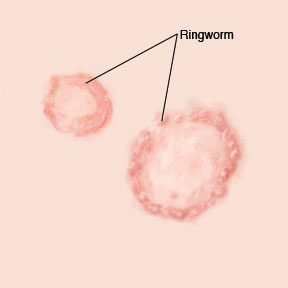Ringworm of the Skin

Ringworm is a fungal infection of the skin. Despite the name, a worm or bug doesn't cause it. It's caused by a fungus that infects the outer layers of the skin.
The medical term for ringworm is tinea. It can affect most parts of your body. But it seems to be more often seen in moist parts of the body and around hair. It can be on almost any part of your body, including:
-
Arms, hands, legs, chest, feet, and back
-
Scalp
-
Beard
-
Groin
-
Between the toes
The type of ringworm is named based on the location of the infection on the body. For example:
-
Tinea capitis (scalp)
-
Tinea cruris (groin, inner thigh, or buttocks)
-
Tinea corporis (body surfaces other than feet, groin, face, scalp, or beard)
-
Tinea pedis (feet)
-
Tinea faciei (face)
-
Tinea manuum (hand)
Causes
Ringworm is very common all over the world, including the U.S. It can take less than 1 week and up to 2 weeks to develop the infection after being exposed. So you may not figure out the exact cause.
It's spread through direct skin-to-skin contact with:
-
An infected person or animal
-
Infected soil, or objects, such as towels, clothing, and combs
-
Surfaces, such as locker room and public showers
Symptoms
Symptoms often appear within 4 to 14 days after the skin comes in contact with the fungus that causes ringworm. At first you might not notice ringworm. Or you may just see a small, red, often raised itchy spot or pimple. Sometimes there may only be 1 spot. At other times there may be several. Ringworm can look slightly different on different parts of the body. But a few things are almost always seen:
-
Irregular, round, oval or ring-shaped. This is why it's called ringworm
-
Clearer or lighter color at the center, since it spreads from the center of the spot outward
-
Red or inflamed look
-
Raised
-
Itchy
-
Scaly, dry, or flaky
-
Hair loss at the site of the rash
Home care
Follow these tips to help care for yourself at home:
-
Leave it alone. Don't scratch at the rash or pick it. This can increase the chance of infection and scarring.
-
Take medicine as prescribed. If you were prescribed a cream, apply it exactly as directed. Make sure to put the cream not just on the rash, but also on the skin, 1 or 2 inches around it. Medicine by mouth is sometimes needed, particularly for ringworm on the scalp. Take it as directed and until your healthcare provider says to stop. Some ringworm creams are available without a prescription (over the counter). Talk with your healthcare provider about these. In some cases, they may be just as effective but less expensive than prescription medicines.
-
Keep it from spreading to others. Untreated ringworm of the skin is contagious by skin-to-skin contact. An affected child may return to school 2 days after treatment has started.
Prevention
To some degree, prevention depends on what part of your body was affected. In general, the following good hygiene can help.
-
Clean up after you get dirty or sweaty, or after using a locker room.
-
When possible, don’t share combs and brushes.
-
Stay away from having your skin and feet wet or damp for long periods.
-
Wear clean, loose-fitting underwear.
Follow-up care
Follow up with your healthcare provider as advised by our staff if the rash does not improve after 10 days of treatment. Or if the rash spreads to other areas of the body.
When to get medical care
Call your healthcare provider right away if any of these occur:
-
Redness around the rash gets worse
-
Fluid drains from the rash
-
Fever of 100.4ºF (38ºC) or higher, or as advised by your provider
Online Medical Reviewer:
L Renee Watson MSN RN
Online Medical Reviewer:
Michael Lehrer MD
Online Medical Reviewer:
Rita Sather RN
Date Last Reviewed:
5/1/2022
© 2000-2024 The StayWell Company, LLC. All rights reserved. This information is not intended as a substitute for professional medical care. Always follow your healthcare professional's instructions.